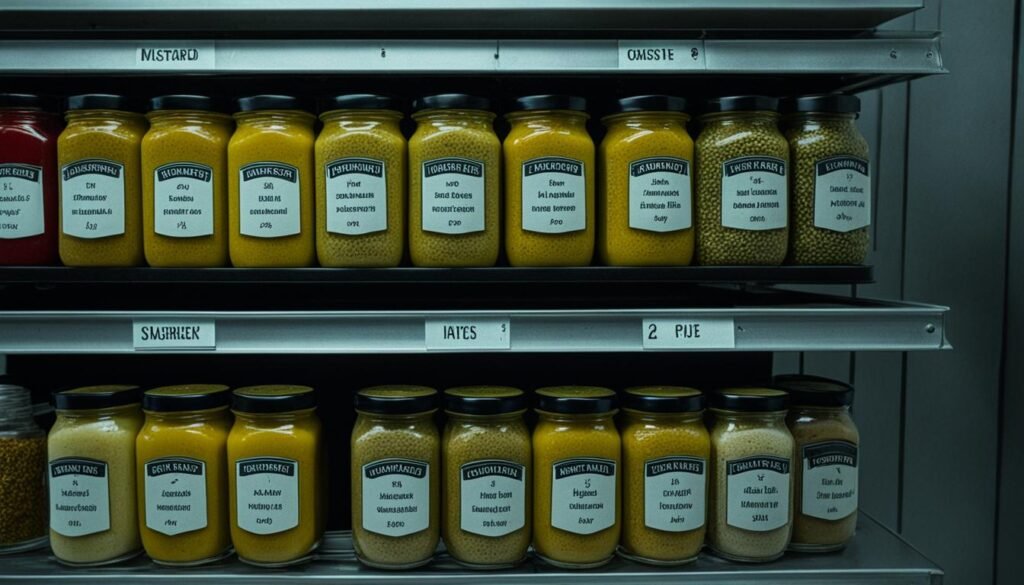Does Mustard Expire? Shelf Life and Storage Tips

Mustard spices up many dishes but doesn’t last forever. This tangy condiment has a long shelf life, yet it can go bad. Let’s explore how to keep your mustard fresh and tasty.
Different mustards have varying shelf lives. Unopened jars can last years, while opened ones need proper care. Good storage habits can keep your mustard flavorful and safe.
We’ll look at what affects mustard’s lifespan. You’ll learn tips to make your mustard last longer. This guide helps both mustard lovers and food storage curious folks.
Key Takeaways
- Mustard does expire, but it has a long shelf life
- Different types of mustard have varying expiration dates
- Proper storage can extend mustard’s freshness
- Expiration dates are quality indicators, not safety measures
- Signs of spoilage include changes in smell, color, and texture
- Refrigeration is recommended after opening
- Homemade mustard has a shorter shelf life than store-bought
Understanding Mustard: A Versatile Condiment
Mustard is a zesty condiment enjoyed worldwide. Its unique flavor makes it a kitchen essential. Let’s explore mustard varieties, ingredients, and the science behind its taste.
Types of Mustard
Mustard comes in various forms with distinct flavors. Popular varieties include:
- Yellow Mustard
- Dijon Mustard
- Honey Mustard
- Whole Grain Mustard
- Chinese Mustard
Common Ingredients in Mustard
Most mustards contain simple yet powerful ingredients. These include:
- Mustard seeds (yellow or brown)
- Vinegar
- Water
- Salt
- Spices
These elements create the tangy, spicy mustard flavor we enjoy. Their combination results in the condiment’s unique taste.
The Science Behind Mustard’s Flavor
Mustard’s pungent flavor comes from a chemical reaction. Crushing mustard seeds and mixing with liquid releases an enzyme. This enzyme breaks down seed compounds, creating the sharp taste.
| Mustard Type | Main Ingredients | Flavor Profile |
|---|---|---|
| Yellow Mustard | Yellow mustard seeds, vinegar, turmeric | Mild, tangy |
| Dijon Mustard | Brown mustard seeds, white wine | Sharp, complex |
| Honey Mustard | Mustard, honey | Sweet, mildly spicy |
| Whole Grain Mustard | Whole mustard seeds, vinegar | Robust, textured |
Knowing these aspects helps you appreciate mustard’s complexity. It also aids in choosing the right variety for your cooking needs.
Does Mustard Expire?
Mustard has a long shelf life due to its high acidity. An unopened jar can last up to two years past the printed date. Proper storage is key to maintaining its quality.
Different mustard types have varying shelf lives. Dry and yellow mustard stay fresh for two years. Dijon and honey mustard can last up to three years. Homemade mustard only lasts one day at room temperature.
Opened store-bought mustards can last about a year in the fridge. Expired mustard isn’t always unsafe to eat. Look for signs of spoilage like mold, off-smells, or texture changes.
| Mustard Type | Unopened Shelf Life | Opened Shelf Life (Refrigerated) |
|---|---|---|
| Dry/Yellow | 2 years | 1 year |
| Dijon/Honey | 3 years | 1 year |
| Homemade | 1 day | 2 weeks |
| Mustard Packets | 6 months | N/A |
Store unopened mustard in a cool, dry place. After opening, keep it in the fridge. Use clean utensils to prevent bacterial growth. With proper care, your mustard can last for months or years.
Shelf Life of Different Mustard Types
Knowing how long mustard lasts is key for taste and safety. Different mustards have varying shelf lives due to their ingredients and acidity.
Dijon Mustard
Dijon mustard can last up to 3 years unopened past its “best by” date. Once opened, it stays good for about 1 year in the fridge.
Yellow Mustard
Yellow mustard lasts 1-2 years unopened. After opening, it keeps for about 1 year when refrigerated.
Honey Mustard
Honey mustard stays fresh for up to 3 years unopened. It lasts about 1 year after opening when kept in the fridge.
Whole Grain Mustard
Whole grain mustard matches Dijon and honey mustard in shelf life. It keeps for up to 3 years unopened and 1 year opened.
Mustard Powder
Dry mustard powder lasts the longest of all mustard types. When stored in a cool, dry place, it stays potent for 3-4 years.
| Mustard Type | Unopened Shelf Life | Opened Shelf Life |
|---|---|---|
| Dijon | 3 years | 1 year |
| Yellow | 1-2 years | 1 year |
| Honey | 3 years | 1 year |
| Whole Grain | 3 years | 1 year |
| Powder | 3-4 years | 3-4 years |
Homemade mustard usually lasts only 1-2 months in the fridge. Storing mustard properly is crucial for keeping it fresh longer.
Factors Affecting Mustard’s Shelf Life
Mustard’s high acidity acts as a natural preservative. It keeps the condiment stable by stopping harmful bacteria from growing. This helps maintain its quality over time.
Environmental factors greatly impact mustard storage. Air, light, and temperature changes can lower mustard’s quality. Store mustard in a cool, dry place away from sunlight to keep it fresh.

The container type affects mustard’s longevity. Glass jars preserve mustard better than plastic squeeze bottles. Glass doesn’t let air in, keeping mustard fresh for longer.
Proper handling extends mustard’s shelf life. Use clean utensils when serving to prevent bacterial contamination. After opening, refrigerate mustard to maintain its quality and safety.
| Factor | Impact on Mustard Shelf Life |
|---|---|
| Acidity | Inhibits pathogen growth |
| Air Exposure | Can degrade quality |
| Light Exposure | May cause flavor changes |
| Temperature Changes | Affects consistency and taste |
| Container Type | Glass preserves better than plastic |
Knowing these factors helps you store mustard properly. You can keep it fresh for longer periods. This way, you’ll enjoy this tasty condiment at its best.
Signs That Your Mustard Has Gone Bad
Spotting expired mustard can prevent an unpleasant taste experience. Mustard lasts long but can still spoil. Let’s explore signs of expired mustard to keep your condiments fresh and safe.
Visual Indicators
Start by checking the mustard’s appearance. Look for these visual cues:
- Mold growth on the surface
- Unusual color changes
- Separation of liquid and solid parts
- Darkening of the mustard paste
Smell and Taste Changes
Your senses can help detect mustard quality. Pay attention to these signs:
- An off or sour smell
- Excessively acidic or bitter flavor
- Any taste that differs from the original mustard flavor
Texture Alterations
The texture of mustard can also indicate spoilage. Watch for these changes:
- Thickening or hardening of the mustard
- Crusty consistency on the surface
- Unusual graininess or lumpiness
Mustard’s shelf life varies by type. Yellow mustard lasts up to 1 year after opening. Whole grain mustard stays fresh for about 1 year when refrigerated.
Always trust your senses over expiration dates. Use them to determine if your mustard is still good.
| Mustard Type | Unopened Shelf Life | Opened Shelf Life (Refrigerated) |
|---|---|---|
| Yellow Mustard | 1-2 years | 1 year |
| Dijon Mustard | 3 years | 1 year |
| Whole Grain Mustard | 1-3 years | 1 year |
| Honey Mustard | 3 years | 1-2 years |
Proper Storage Techniques for Mustard
Storing mustard correctly keeps it fresh longer. Good techniques ensure you always have tasty mustard ready. Learn how to preserve your favorite condiment effectively.

Unopened mustard can last two years in a cool, dry pantry. Once opened, refrigerate it. Refrigerated mustard stays fresh for months. At room temperature, it only lasts about two months.
Different mustard types have varying shelf lives. Here’s a quick guide:
| Mustard Type | Unopened (Pantry) | Opened (Refrigerated) |
|---|---|---|
| American | 1-2 years past expiry | 1 year |
| Dijon | 2-3 years | 1 year |
| Honey Mustard | 2-3 years | 1-2 years |
| Chinese | 1-2 years | 1 year |
| Homemade | Not recommended | 1 week – 1 year |
Keep opened jars in the fridge for best results. Use clean utensils when serving to prevent contamination. This helps extend the mustard’s shelf life.
Glass jars keep mustard fresh for up to two years. Plastic squeeze bottles maintain freshness for about 18 months.
The Truth About Expiration Dates on Mustard
Mustard expiration dates often puzzle consumers. These dates focus on quality, not safety. Properly stored mustard can be safe to eat past its printed date.
Understanding “Best By” Dates
Best by dates show when mustard is at peak quality. They don’t mean the product is unsafe after that date. Unopened mustard lasts up to 12 months in the pantry.
Refrigerated mustard stays good for about 12 months after opening. This is longer than many other condiments.
USDA Guidelines on Food Dating
The USDA says freshness dates indicate quality, not safety. They suggest using your senses to check if mustard is still good. This method is more reliable than printed dates.
Mustard has a longer shelf life than mayo. Mayo should be tossed two months after opening.
“With proper storage, mustard can maintain its quality for up to a year after opening if kept in the refrigerator.”
Mustard lasts longer than other condiments. Ketchup is only good for about six months after opening and refrigerating.
Always check for spoilage signs before eating any condiment. This applies regardless of the best by date.
How to Extend Your Mustard’s Shelf Life
Keeping mustard fresh is simpler than you’d expect. Proper storage is crucial for longevity. Refrigeration can extend opened mustard’s life by up to two years past its ‘Best by’ date.
Always use clean utensils when serving mustard. This prevents bacterial growth and maintains freshness. For homemade mustard, use airtight containers and refrigerate right away.
Mustard’s natural acidity acts as a preservative. This contributes to its long shelf life. If your mustard dries out, add a splash of vinegar, water, or wine.
Check for signs of spoilage before reviving dried mustard. By following these tips, you’ll enjoy mustard’s zesty flavor for months.
FAQ
Does mustard expire?
Yes, mustard does expire, but it has a long shelf life. Different types of mustard can last 1-3 years unopened. After opening, refrigerated mustard can stay good for 1-2 years.
What factors affect mustard’s shelf life?
Mustard’s high acidity helps it last longer by stopping bacteria growth. Air, light, and temperature changes can make mustard go bad faster. Glass jars keep mustard fresh longer than plastic squeeze bottles.
How can I tell if my mustard has gone bad?
Look for liquid separation and thickening of the solid part. Bad mustard may have an unpleasant smell or taste too acidic or bitter. You might also see mold, color changes, or a crusty texture.
How should I store mustard?
Keep unopened mustard in a cool, dry place. Once opened, store it in the fridge below 40°F. Use airtight containers to keep out moisture and germs.
Always use clean utensils when serving to avoid spreading bacteria.
What do expiration dates on mustard mean?
Expiration dates on mustard are about quality, not safety. The USDA says these dates show when mustard tastes best. You can often eat mustard after this date if it’s stored right.
How can I extend my mustard’s shelf life?
Keep mustard in the fridge after opening. Close the container tightly to protect it from light and air. Use clean utensils when serving to avoid germs.
For homemade mustard, refrigerate right away in airtight containers.





